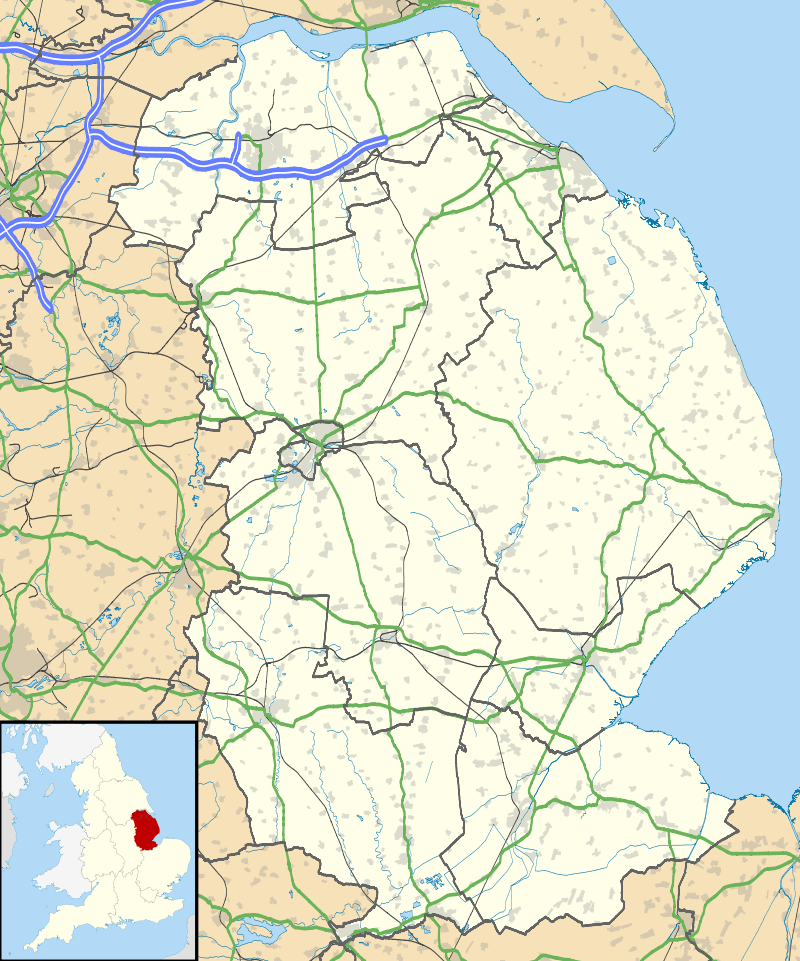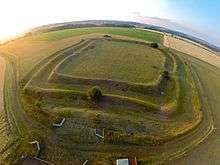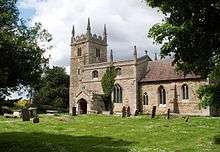Honington, Lincolnshire
| Honington | |
 St Wilfrid's Church and vicarage, Honington |
|
 Honington |
|
| Population | 133 (2001) |
|---|---|
| OS grid reference | SK947431 |
| – London | 100 mi (160 km) S |
| District | South Kesteven |
| Shire county | Lincolnshire |
| Region | East Midlands |
| Country | England |
| Sovereign state | United Kingdom |
| Post town | Grantham |
| Postcode district | NG32 |
| Police | Lincolnshire |
| Fire | Lincolnshire |
| Ambulance | East Midlands |
| EU Parliament | East Midlands |
| UK Parliament | Sleaford and North Hykeham |
|
|
Coordinates: 52°58′37″N 0°35′27″W / 52.976995°N 0.59084°W
Honington is a village and civil parish in the South Kesteven district of Lincolnshire, England. It lies just north of the junction between the A153 and A607 roads, about 5.5 miles (8.9 km) north from Grantham and 8 miles (12.9 km) west from Sleaford.
History

To the east of Honington are earthwork remains of an Iron Age fort, measuring 130-metre (430 ft) by 116-metre (381 ft) with defensive banks and ditches. In 1691 a hoard of Roman coins were found, although an investigation of 1976 found no evidence of Roman occupation.[1][2] The 1885 Kelly's Directory view of the earthworks "on the heath near the village" is that it is the site of a Roman Camp with fosse and vallum.[3]
In the Domesday account Honington is written as "Hondintone", "Hundindune" and "Hundinton".[4] Before the Conquest lordship was held by Godwin of Barrowby, and after by Ivo Tallboys.[5] The village belonged to the historical wapentake of Winnibriggs and Threo.[6]
Kelly's noted that Honington was a parish and railway station on the Grantham, Sleaford and Boston branch of the Great Northern Railway, at the junction of the Lincoln line. Agricultural production was chiefly wheat barley oats turnips and seeds, in a parish area of 1,454 acres (5.88 km2) with an 1881 population of 177. The Lord of the Manor and sole landowner was Edward Southwell Trafford of Wroxham Hall, Norwich.[3]
Honington Hall, the seat of James Hornsby JP was erected in 1862-63, a stone building in Elizabethan style with an attached observatory tower. A parochial school was built in 1863 for 60 children of both sexes.[3]
In December 2015 Fibre to the Cabinet Broadband was installed in the village as part of a Lincolnshire-wide scheme to upgrade the infrastructure
Church

The ecclesiastical parish of Honington has the same boundaries as the civil parish, and is part of The Barkston and Hough Group of the Loveden Deanery of the Diocese of Lincoln. The originally 11th-century Anglican parish church, dedicated to St Wilfrid, is Grade II listed.[7] The 2013 incumbent is The Revd Alan Littlewood.[8]
Kelly's noted that the church of St Wilfrid seated 120 people. It is in Norman, Early English and later styles, and consists of a chancel with a north aisle or chapel, a clerestoried nave of two bays, a porch, and a square tower of Early English date, with a Perpendicular parapet and pinnacles, containing three bells. The north aisle is late Perpendicular and the chancel arch encloses the remains of a stone screen. The original aisle or chapel was built by the Hussey family in reign of Henry VIII. At the west end of the chapel is a stone monument with figure to William Smith, d.1550, his wife, a daughter of Augustine Porter of Belton, and 6 children. In the pavement of the chancel is a grey slab, formerly commemorating a priest whose effigy partly remains, but now covered by a brass plate inscribed to John Hussey, d.1553, benefactor to Honington parish and Caythorpe. In 1873 the nave was restored and reseated, and the interior of the tower restored.[3] Pevsner notes further monuments, including a bust of Thomas Hussey, d.1697, and an architectural tomb to Dame Sarah Hussey, d. 1714, and also a 17th-century communion rail, a 1577 gilt beaker, and a 1732 paten and flagon by Benjamin Godfrey.[2]
References
- ↑ Historic England. "Honington Camp (325900)". PastScape. Retrieved 24 October 2011.
- 1 2 Pevsner, Nikolaus; Harris, John; The Buildings of England: Lincolnshire pp. 576, 577; Penguin, (1964); revised by Nicholas Antram (1989), Yale University Press. ISBN 0-300-09620-8
- 1 2 3 4 Kelly's Directory of Lincolnshire with the port of Hull 1885, p. 483
- ↑ "Documents Online: Honington", Folios: 351v, 355v, 377v, Great Domesday Book; The National Archives. Retrieved 21 December 2011
- ↑ "Honington", Domesdaymap.co.uk. Retrieved 21 December 2011
- ↑ Vision of Britain site: Retrieved 16 March 2012.
- ↑ Historic England. "Church of St Wilfrid (1062413)". National Heritage List for England. Retrieved 21 December 2011.
- ↑ Honington P C C, Diocese of Lincoln. Retrieved 12 December 2011
External links
 Media related to Honington, Lincolnshire at Wikimedia Commons
Media related to Honington, Lincolnshire at Wikimedia Commons- "Honington", Genuki.org.uk. Retrieved 12 December 2011
- "Honington Parish Meeting", Lincolnshire.gov.uk. Retrieved 12 December 2011